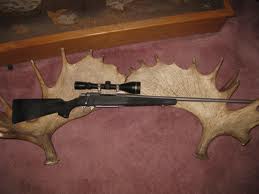 The Browning A-Bolt is the “modern convenience” version of the tried-and-true bolt action. It’s sleeker looking and incorporates seemingly more user-friendly technologies, but in the end, it’s a bolt-action hunting gun like the rest of the batch.
The Browning A-Bolt is the “modern convenience” version of the tried-and-true bolt action. It’s sleeker looking and incorporates seemingly more user-friendly technologies, but in the end, it’s a bolt-action hunting gun like the rest of the batch.
The Rifle: Browning A-Bolt
The Caliber: .300 Winchester Magnum
The Animal: Moose
The Rifle – Browning A-Bolt
The Browning A-Bolt (specifically the A-Bolt II long-range hunter variant in stainless steel) is a whole lot of rifle. With an all stainless-steel, heavy-barreled, composite stock with camouflage; a 26-inch match-grade barrel; and overall weight of only 8 pounds and 5 ounces, this hunting package is actually quite reasonable at around $1000. Historically, the Browning hunting rifles like the A-Bolt weren’t priced as reasonably as their competition, and the average hunter would often times feel like they were paying for fit and finish in excess. Although the A-bolt is generally a beautiful weapon, this specific variant doesn’t do much with its textured composite stock to portray the classic lines of the A-Bolts of years past. Other variants do a much better job of showing the sleek lines and quality finish of the classic A-Bolt. This weapon, while perhaps an excellent value, is more about utility than it is about good looks.
The stainless-steel receiver is bead blasted with a matte finish, fully glass bedded, and factory drilled and tapped to accept scope mounts. The exterior of the all stainless-steel 26-inch bull–style barrel is fluted, free floated, and hand reamed in the chamber, and it is crowned at the muzzle end with a beveled target-style crowning. The bolt is a non-rotating Browning design with a 60° maximum angle, which incorporates an adjustable trigger, a removable magazine, and a shotgun-style top safety. The composite stock and palm area come tricked out with swells and a “Mossy Oak” finished camouflage, plus a durable finish protection. Factory fitted with a recoil pad and sling swivel studs, this gun seems to be well outfitted from factory.
The Caliber – .300 Winchester Magnum
The .300 Winchester Magnum cartridge is incredibly popular throughout the world as both a highly functional caliber as well as one that has a decent history. It’s been around since the early 1960s and has seen use as an anti-material and sniping cartridge adopted by the United States military. Having since been phased out in favor of the somewhat more powerful .338 Lapua, the .300 Winchester Magnum still shows incredible ballistics, excellent trajectories, and unbelievable killing potential. It’s usable on light to even domestic large game, though it is perhaps best suited to medium/large game like large elk and moose. It’s probably significantly more comfortable than most cartridges at dispatching the most aggressive and largest North American animals, including bears. Often compared to the 7 mm Remington Magnum, the .300 Winchester Magnum is particularly adept at killing larger animals than the 7 mm Remington Magnum, though there will be some additional recoil and penetration. The .300 Winchester Magnum is unusually well-suited to animals between 250 and 1,250 pounds (all depending on the specific bullet weight used).
150-grain loads typically move around 3200 ft./s, with typical speeds for a 180-grain bullet at around 2900 to 3000 ft./s. In the lighter grain weights, specifically the 130-grain projectile, one might expect speeds to exceed 3400 ft./s, in comparison to medium grain bullets like the 165-grain, which is fairly steady around 3150 ft./s.
With 180-grain bullets, an animal between 250 and 750 pounds can reasonably be expected to be taken with a singular shot—almost always producing an instantaneous death. Of course shot placement, as always, will be the best determining factor on how quickly and easily an animal is dispatched. Having a massive amount of muzzle energy combined with screaming fast velocities will not hurt in that equation – enter the .300 Winchester Magnum.
With 200 to 220-grain bullets, animals between 600 and 1250 pounds can reasonably be expected to be taken with a singular shot; however with animals that large, shot placement will be of extreme importance.
Again, the primary difference between the 7 mm Remington Magnum and the .300 Winchester Magnum is that the .300 Winchester Magnum pushes out a bigger projectile, has more muzzle energy, and has a heavier recoil.
The Animal –Moose
While there are several different variants in the moose family, it’s typical to see adult males between 1,200 and 2,000 pounds, with females between 850 and 1,400 pounds. Moose, in general, have an awkward look about them, and their distinctive facial features give no insight into their relatively athletic and capable personas. Usually they pick a specific spot to “homestead” for most of the year, with the exception being in the fall season where the bulls usually travel a few miles from their normal location looking for mates.
Generally speaking, the moose environment varies heavily from swampy, muddy, and wet locations to heavily forested higher areas. Areas dense in young forest, including small trunk trees, where heavy water pooling is really consistent, will be an excellent place to find moose. It’s a little less difficult to hunt moose, relatively speaking (compared to some other medium-to-large-sized game animals) as a result of their sensory abilities; however, their athletic capabilities and massive size tend to even the odds out.
For first-time moose hunters, it may be well advised to seek the services of a qualified guide or spend a substantial amount of time researching, planning, and preparing for the hunt.
The ability to shoot at 200 yards (or at least past 150 yards) is paramount in both Alaskan and American North Eastern hunting grounds (two areas with heavy moose density). A large majority of the shots taken on the moose will likely be at this range. For hunting moose on foot, the wetter the better. After a good rain or snow, scents and sounds will be muted, and the animals will be more likely to be out.
Moose calls and stand hunting may be an easier inroad to a successful kill; if planned properly, it’s just a matter of time. Patience is incredibly important in a moose hunt and will prove to be almost as important as the preparation for the trip.
Meat from a moose is lean and mildly gamey like deer meat, with a heavy flavor profile and the little bit of sweetness not unlike bear meat. Most people tend to favor moose over almost all other game meats; and while the flavor is heavy, the texture has a finer grain pattern and cooks better than most other game meats.
It’s usually a waiting game on the hunt for moose, so when you finally have one in your sights, it’s important that you have what it takes to dispatch the animal and complete your hunt. A Browning A-Bolt with a stainless-steel heavy barrel and a good scope with some high-quality .300 Winchester Magnum rounds are an excellent set of variables to be working with in this specific setting. The heavy bullet weights, high velocity, and weatherproof rifle build make a great combination.
©2011 Off the Grid News
 Off The Grid News Better Ideas For Off The Grid Living
Off The Grid News Better Ideas For Off The Grid Living



